HLSC Nursing Assignment: Ethical Dilemmas in Healthcare Practices
VerifiedAdded on 2021/05/31
|7
|2137
|52
Essay
AI Summary
This essay critically examines ethical issues within healthcare, using a case study of a student, Amos, who was denied treatment and subsequently died. The essay highlights violations of human rights, dignity, and patient autonomy. It explores ethical principles such as non-maleficence, beneficence, and autonomy, and discusses how conflicts arise in healthcare settings. The analysis includes the Australian Charter of Healthcare Rights and the Australian Nursing and Midwifery Council's code of ethics. The essay suggests recommendations to address these ethical issues, emphasizing the importance of patient-centered care, healthcare professionals' training, and the significance of virtue ethics. The essay concludes that ethical decision-making, respect for patient rights, and the application of ethical codes are crucial for quality healthcare delivery and the prevention of ethical dilemmas. The essay emphasizes the importance of ethical considerations in healthcare, highlighting the need for healthcare professionals to adhere to ethical guidelines and codes of conduct to ensure patient well-being and uphold human rights.
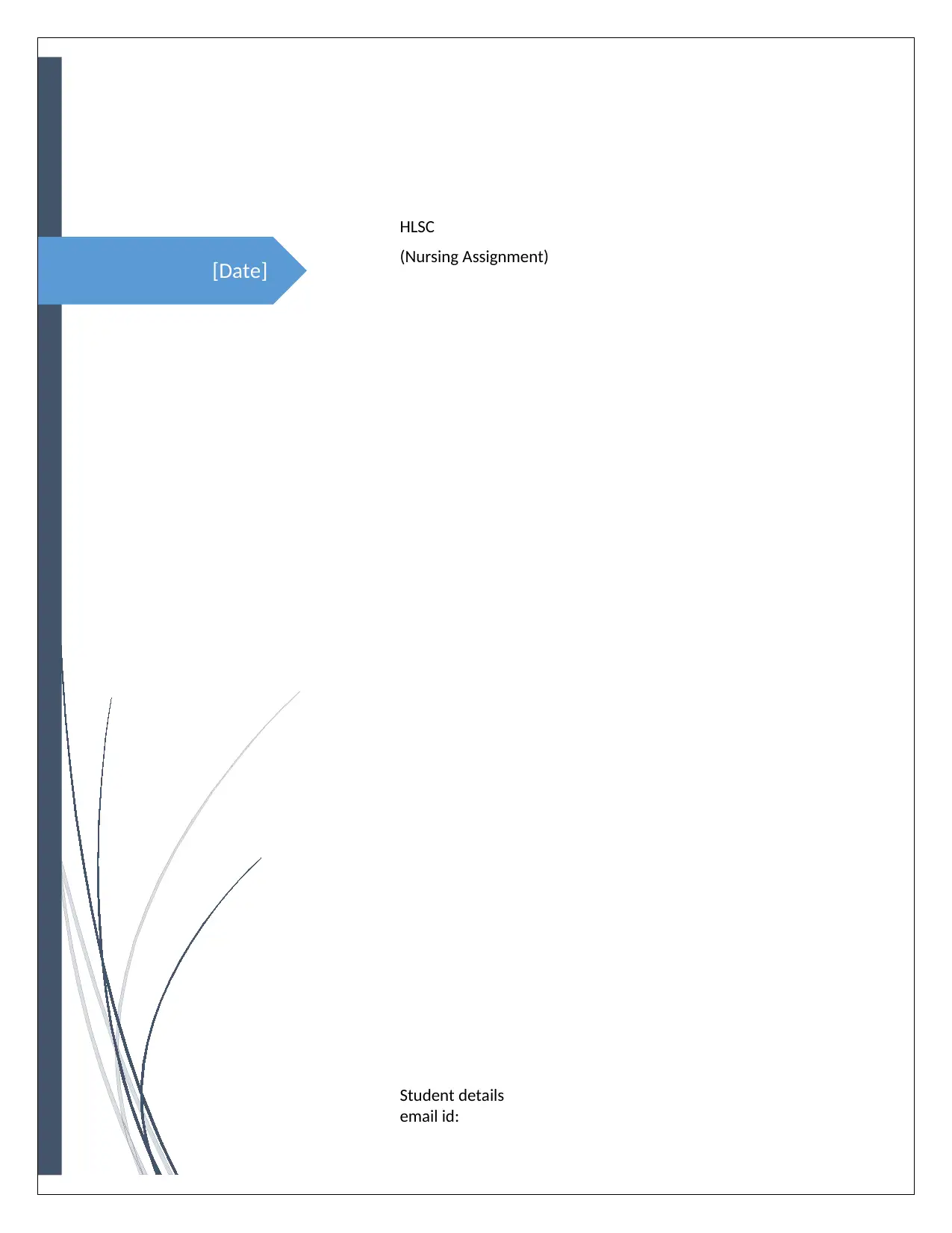
[Date]
HLSC
(Nursing Assignment)
Student details
email id:
HLSC
(Nursing Assignment)
Student details
email id:
Paraphrase This Document
Need a fresh take? Get an instant paraphrase of this document with our AI Paraphraser
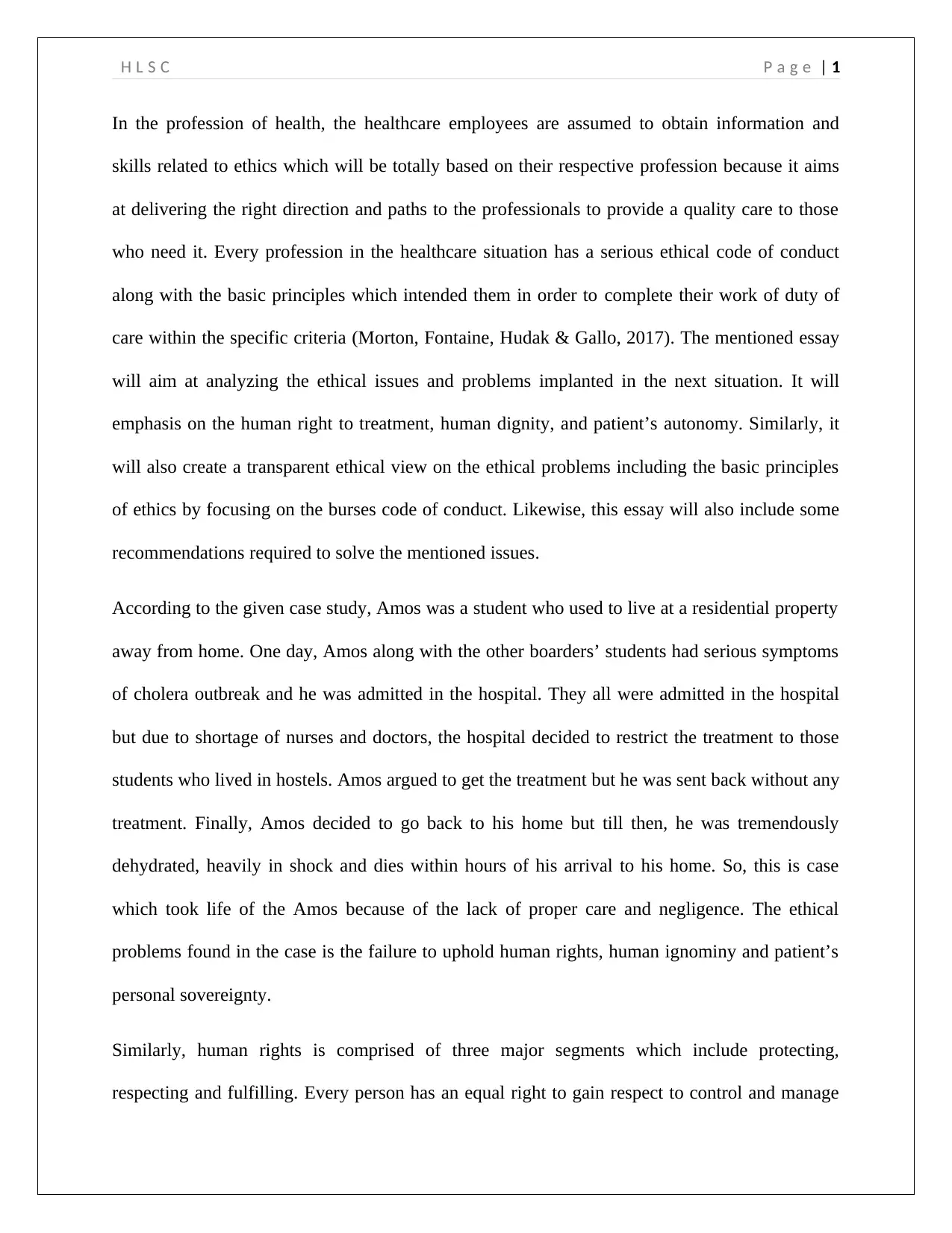
H L S C P a g e | 1
In the profession of health, the healthcare employees are assumed to obtain information and
skills related to ethics which will be totally based on their respective profession because it aims
at delivering the right direction and paths to the professionals to provide a quality care to those
who need it. Every profession in the healthcare situation has a serious ethical code of conduct
along with the basic principles which intended them in order to complete their work of duty of
care within the specific criteria (Morton, Fontaine, Hudak & Gallo, 2017). The mentioned essay
will aim at analyzing the ethical issues and problems implanted in the next situation. It will
emphasis on the human right to treatment, human dignity, and patient’s autonomy. Similarly, it
will also create a transparent ethical view on the ethical problems including the basic principles
of ethics by focusing on the burses code of conduct. Likewise, this essay will also include some
recommendations required to solve the mentioned issues.
According to the given case study, Amos was a student who used to live at a residential property
away from home. One day, Amos along with the other boarders’ students had serious symptoms
of cholera outbreak and he was admitted in the hospital. They all were admitted in the hospital
but due to shortage of nurses and doctors, the hospital decided to restrict the treatment to those
students who lived in hostels. Amos argued to get the treatment but he was sent back without any
treatment. Finally, Amos decided to go back to his home but till then, he was tremendously
dehydrated, heavily in shock and dies within hours of his arrival to his home. So, this is case
which took life of the Amos because of the lack of proper care and negligence. The ethical
problems found in the case is the failure to uphold human rights, human ignominy and patient’s
personal sovereignty.
Similarly, human rights is comprised of three major segments which include protecting,
respecting and fulfilling. Every person has an equal right to gain respect to control and manage
In the profession of health, the healthcare employees are assumed to obtain information and
skills related to ethics which will be totally based on their respective profession because it aims
at delivering the right direction and paths to the professionals to provide a quality care to those
who need it. Every profession in the healthcare situation has a serious ethical code of conduct
along with the basic principles which intended them in order to complete their work of duty of
care within the specific criteria (Morton, Fontaine, Hudak & Gallo, 2017). The mentioned essay
will aim at analyzing the ethical issues and problems implanted in the next situation. It will
emphasis on the human right to treatment, human dignity, and patient’s autonomy. Similarly, it
will also create a transparent ethical view on the ethical problems including the basic principles
of ethics by focusing on the burses code of conduct. Likewise, this essay will also include some
recommendations required to solve the mentioned issues.
According to the given case study, Amos was a student who used to live at a residential property
away from home. One day, Amos along with the other boarders’ students had serious symptoms
of cholera outbreak and he was admitted in the hospital. They all were admitted in the hospital
but due to shortage of nurses and doctors, the hospital decided to restrict the treatment to those
students who lived in hostels. Amos argued to get the treatment but he was sent back without any
treatment. Finally, Amos decided to go back to his home but till then, he was tremendously
dehydrated, heavily in shock and dies within hours of his arrival to his home. So, this is case
which took life of the Amos because of the lack of proper care and negligence. The ethical
problems found in the case is the failure to uphold human rights, human ignominy and patient’s
personal sovereignty.
Similarly, human rights is comprised of three major segments which include protecting,
respecting and fulfilling. Every person has an equal right to gain respect to control and manage
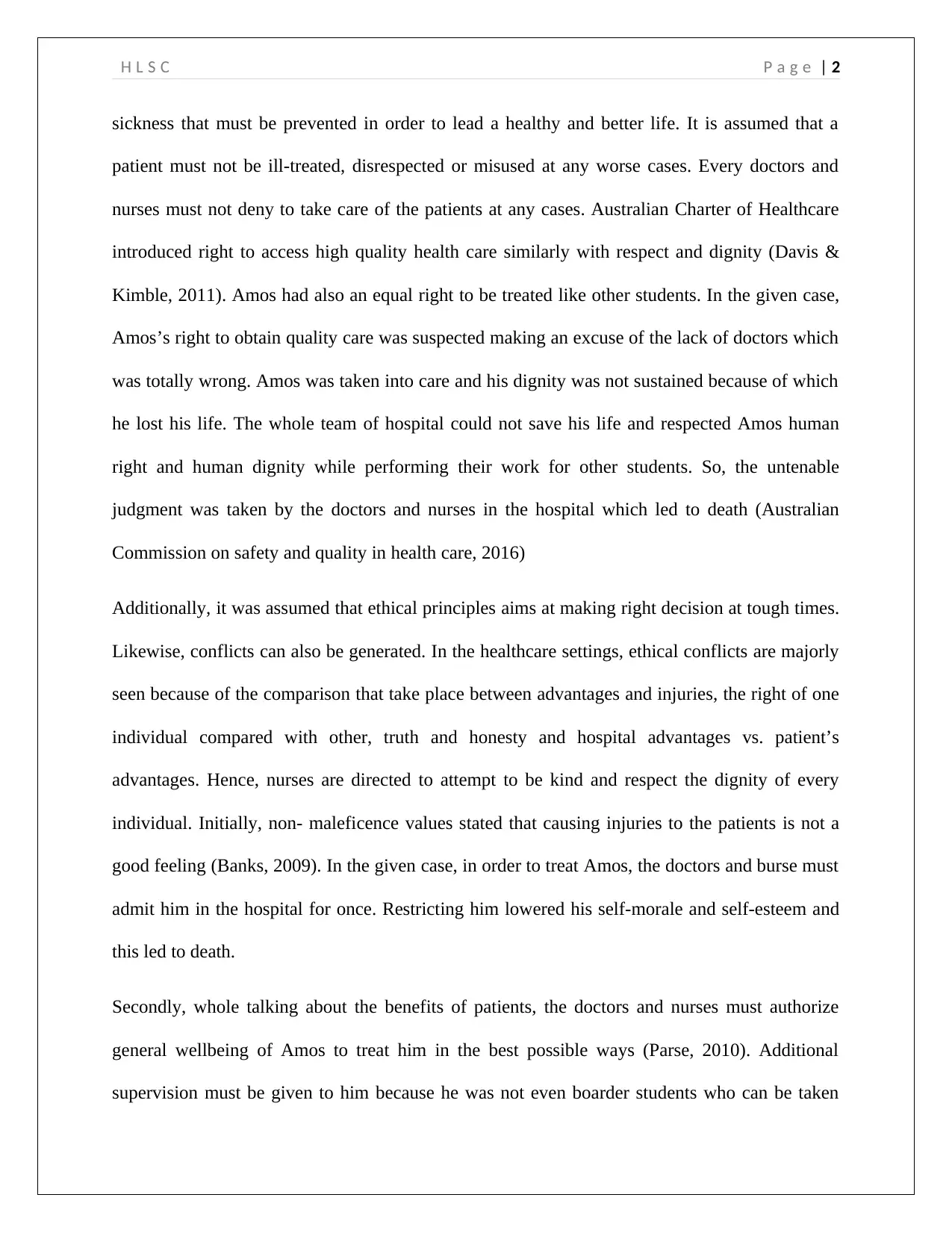
H L S C P a g e | 2
sickness that must be prevented in order to lead a healthy and better life. It is assumed that a
patient must not be ill-treated, disrespected or misused at any worse cases. Every doctors and
nurses must not deny to take care of the patients at any cases. Australian Charter of Healthcare
introduced right to access high quality health care similarly with respect and dignity (Davis &
Kimble, 2011). Amos had also an equal right to be treated like other students. In the given case,
Amos’s right to obtain quality care was suspected making an excuse of the lack of doctors which
was totally wrong. Amos was taken into care and his dignity was not sustained because of which
he lost his life. The whole team of hospital could not save his life and respected Amos human
right and human dignity while performing their work for other students. So, the untenable
judgment was taken by the doctors and nurses in the hospital which led to death (Australian
Commission on safety and quality in health care, 2016)
Additionally, it was assumed that ethical principles aims at making right decision at tough times.
Likewise, conflicts can also be generated. In the healthcare settings, ethical conflicts are majorly
seen because of the comparison that take place between advantages and injuries, the right of one
individual compared with other, truth and honesty and hospital advantages vs. patient’s
advantages. Hence, nurses are directed to attempt to be kind and respect the dignity of every
individual. Initially, non- maleficence values stated that causing injuries to the patients is not a
good feeling (Banks, 2009). In the given case, in order to treat Amos, the doctors and burse must
admit him in the hospital for once. Restricting him lowered his self-morale and self-esteem and
this led to death.
Secondly, whole talking about the benefits of patients, the doctors and nurses must authorize
general wellbeing of Amos to treat him in the best possible ways (Parse, 2010). Additional
supervision must be given to him because he was not even boarder students who can be taken
sickness that must be prevented in order to lead a healthy and better life. It is assumed that a
patient must not be ill-treated, disrespected or misused at any worse cases. Every doctors and
nurses must not deny to take care of the patients at any cases. Australian Charter of Healthcare
introduced right to access high quality health care similarly with respect and dignity (Davis &
Kimble, 2011). Amos had also an equal right to be treated like other students. In the given case,
Amos’s right to obtain quality care was suspected making an excuse of the lack of doctors which
was totally wrong. Amos was taken into care and his dignity was not sustained because of which
he lost his life. The whole team of hospital could not save his life and respected Amos human
right and human dignity while performing their work for other students. So, the untenable
judgment was taken by the doctors and nurses in the hospital which led to death (Australian
Commission on safety and quality in health care, 2016)
Additionally, it was assumed that ethical principles aims at making right decision at tough times.
Likewise, conflicts can also be generated. In the healthcare settings, ethical conflicts are majorly
seen because of the comparison that take place between advantages and injuries, the right of one
individual compared with other, truth and honesty and hospital advantages vs. patient’s
advantages. Hence, nurses are directed to attempt to be kind and respect the dignity of every
individual. Initially, non- maleficence values stated that causing injuries to the patients is not a
good feeling (Banks, 2009). In the given case, in order to treat Amos, the doctors and burse must
admit him in the hospital for once. Restricting him lowered his self-morale and self-esteem and
this led to death.
Secondly, whole talking about the benefits of patients, the doctors and nurses must authorize
general wellbeing of Amos to treat him in the best possible ways (Parse, 2010). Additional
supervision must be given to him because he was not even boarder students who can be taken
⊘ This is a preview!⊘
Do you want full access?
Subscribe today to unlock all pages.

Trusted by 1+ million students worldwide
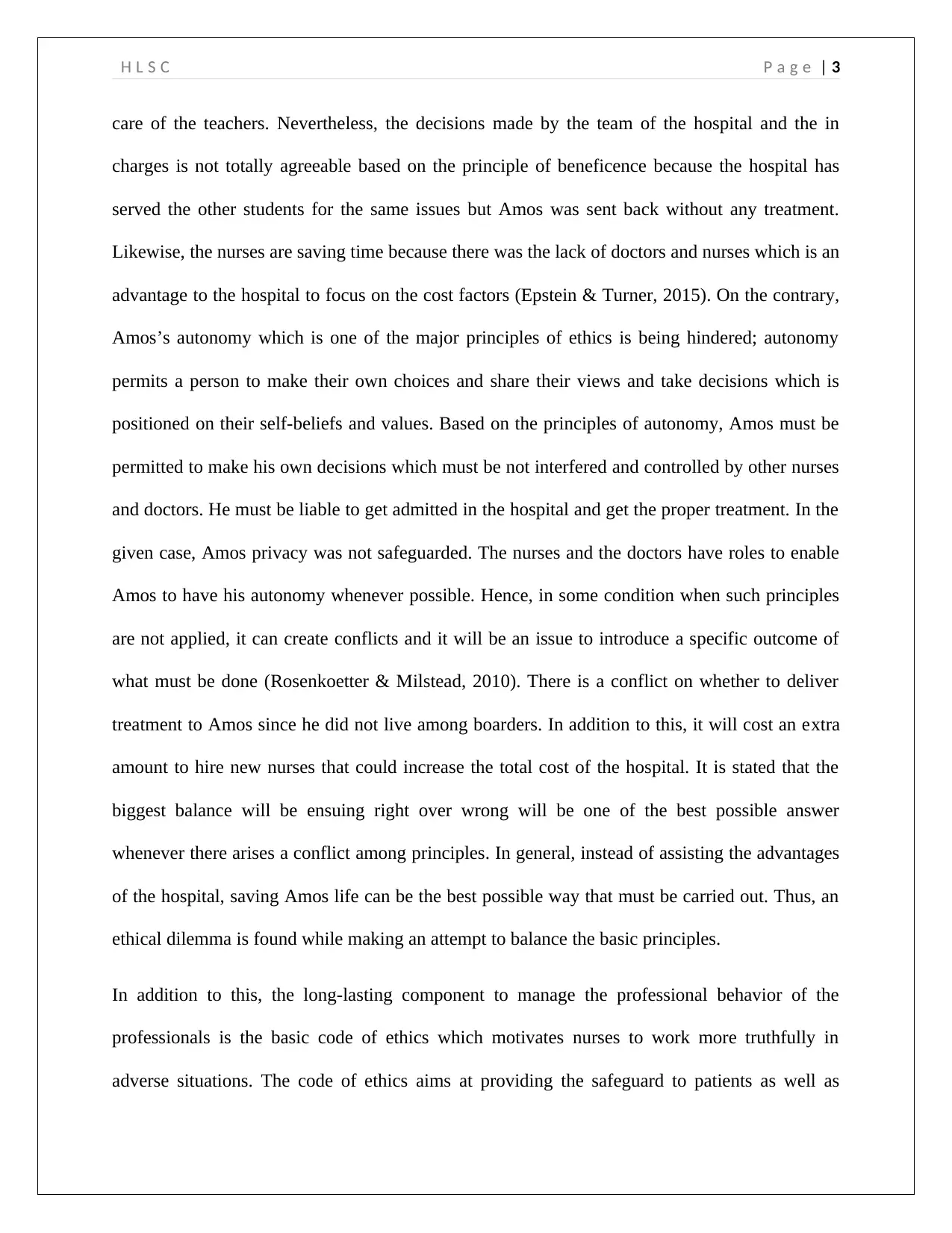
H L S C P a g e | 3
care of the teachers. Nevertheless, the decisions made by the team of the hospital and the in
charges is not totally agreeable based on the principle of beneficence because the hospital has
served the other students for the same issues but Amos was sent back without any treatment.
Likewise, the nurses are saving time because there was the lack of doctors and nurses which is an
advantage to the hospital to focus on the cost factors (Epstein & Turner, 2015). On the contrary,
Amos’s autonomy which is one of the major principles of ethics is being hindered; autonomy
permits a person to make their own choices and share their views and take decisions which is
positioned on their self-beliefs and values. Based on the principles of autonomy, Amos must be
permitted to make his own decisions which must be not interfered and controlled by other nurses
and doctors. He must be liable to get admitted in the hospital and get the proper treatment. In the
given case, Amos privacy was not safeguarded. The nurses and the doctors have roles to enable
Amos to have his autonomy whenever possible. Hence, in some condition when such principles
are not applied, it can create conflicts and it will be an issue to introduce a specific outcome of
what must be done (Rosenkoetter & Milstead, 2010). There is a conflict on whether to deliver
treatment to Amos since he did not live among boarders. In addition to this, it will cost an extra
amount to hire new nurses that could increase the total cost of the hospital. It is stated that the
biggest balance will be ensuing right over wrong will be one of the best possible answer
whenever there arises a conflict among principles. In general, instead of assisting the advantages
of the hospital, saving Amos life can be the best possible way that must be carried out. Thus, an
ethical dilemma is found while making an attempt to balance the basic principles.
In addition to this, the long-lasting component to manage the professional behavior of the
professionals is the basic code of ethics which motivates nurses to work more truthfully in
adverse situations. The code of ethics aims at providing the safeguard to patients as well as
care of the teachers. Nevertheless, the decisions made by the team of the hospital and the in
charges is not totally agreeable based on the principle of beneficence because the hospital has
served the other students for the same issues but Amos was sent back without any treatment.
Likewise, the nurses are saving time because there was the lack of doctors and nurses which is an
advantage to the hospital to focus on the cost factors (Epstein & Turner, 2015). On the contrary,
Amos’s autonomy which is one of the major principles of ethics is being hindered; autonomy
permits a person to make their own choices and share their views and take decisions which is
positioned on their self-beliefs and values. Based on the principles of autonomy, Amos must be
permitted to make his own decisions which must be not interfered and controlled by other nurses
and doctors. He must be liable to get admitted in the hospital and get the proper treatment. In the
given case, Amos privacy was not safeguarded. The nurses and the doctors have roles to enable
Amos to have his autonomy whenever possible. Hence, in some condition when such principles
are not applied, it can create conflicts and it will be an issue to introduce a specific outcome of
what must be done (Rosenkoetter & Milstead, 2010). There is a conflict on whether to deliver
treatment to Amos since he did not live among boarders. In addition to this, it will cost an extra
amount to hire new nurses that could increase the total cost of the hospital. It is stated that the
biggest balance will be ensuing right over wrong will be one of the best possible answer
whenever there arises a conflict among principles. In general, instead of assisting the advantages
of the hospital, saving Amos life can be the best possible way that must be carried out. Thus, an
ethical dilemma is found while making an attempt to balance the basic principles.
In addition to this, the long-lasting component to manage the professional behavior of the
professionals is the basic code of ethics which motivates nurses to work more truthfully in
adverse situations. The code of ethics aims at providing the safeguard to patients as well as
Paraphrase This Document
Need a fresh take? Get an instant paraphrase of this document with our AI Paraphraser
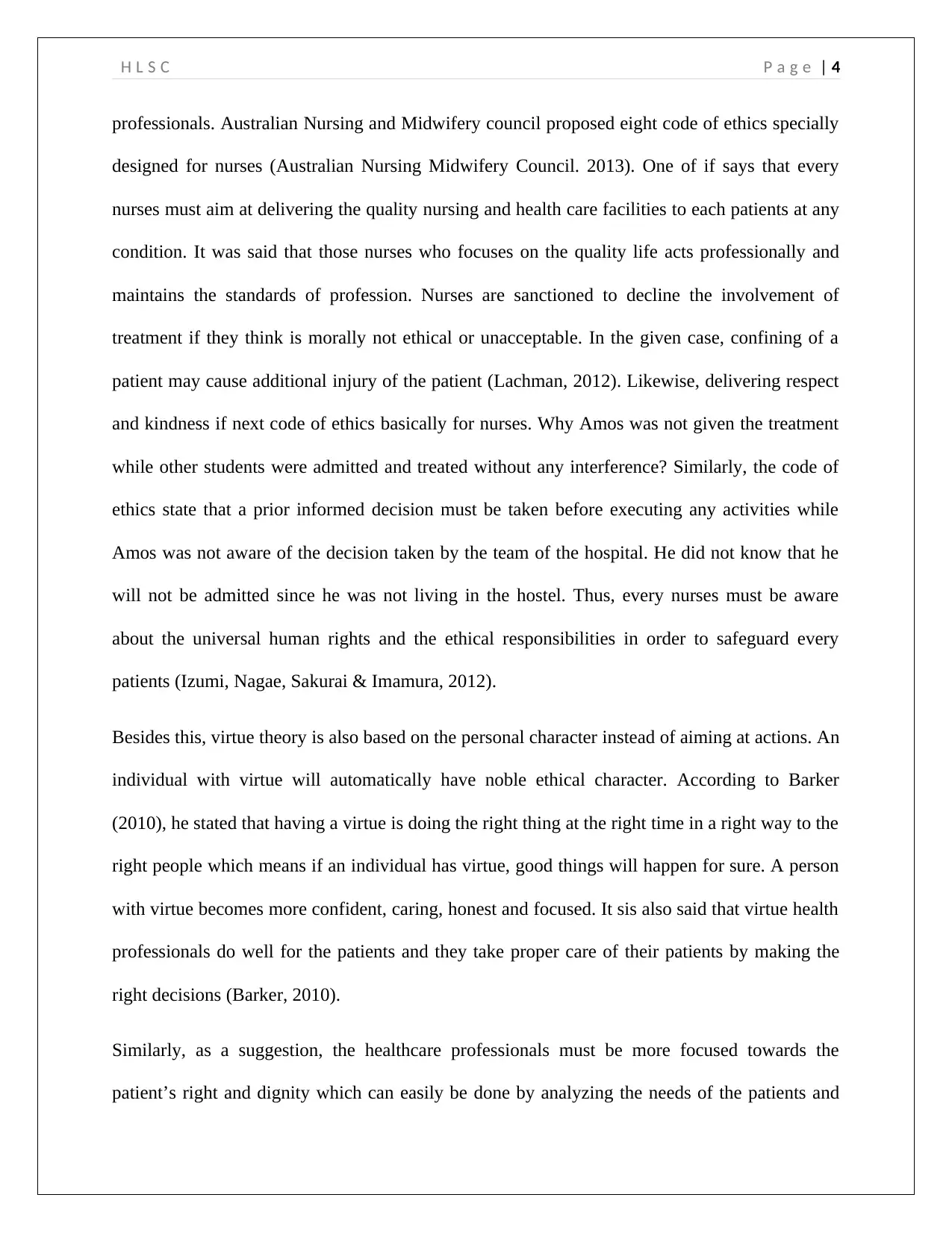
H L S C P a g e | 4
professionals. Australian Nursing and Midwifery council proposed eight code of ethics specially
designed for nurses (Australian Nursing Midwifery Council. 2013). One of if says that every
nurses must aim at delivering the quality nursing and health care facilities to each patients at any
condition. It was said that those nurses who focuses on the quality life acts professionally and
maintains the standards of profession. Nurses are sanctioned to decline the involvement of
treatment if they think is morally not ethical or unacceptable. In the given case, confining of a
patient may cause additional injury of the patient (Lachman, 2012). Likewise, delivering respect
and kindness if next code of ethics basically for nurses. Why Amos was not given the treatment
while other students were admitted and treated without any interference? Similarly, the code of
ethics state that a prior informed decision must be taken before executing any activities while
Amos was not aware of the decision taken by the team of the hospital. He did not know that he
will not be admitted since he was not living in the hostel. Thus, every nurses must be aware
about the universal human rights and the ethical responsibilities in order to safeguard every
patients (Izumi, Nagae, Sakurai & Imamura, 2012).
Besides this, virtue theory is also based on the personal character instead of aiming at actions. An
individual with virtue will automatically have noble ethical character. According to Barker
(2010), he stated that having a virtue is doing the right thing at the right time in a right way to the
right people which means if an individual has virtue, good things will happen for sure. A person
with virtue becomes more confident, caring, honest and focused. It sis also said that virtue health
professionals do well for the patients and they take proper care of their patients by making the
right decisions (Barker, 2010).
Similarly, as a suggestion, the healthcare professionals must be more focused towards the
patient’s right and dignity which can easily be done by analyzing the needs of the patients and
professionals. Australian Nursing and Midwifery council proposed eight code of ethics specially
designed for nurses (Australian Nursing Midwifery Council. 2013). One of if says that every
nurses must aim at delivering the quality nursing and health care facilities to each patients at any
condition. It was said that those nurses who focuses on the quality life acts professionally and
maintains the standards of profession. Nurses are sanctioned to decline the involvement of
treatment if they think is morally not ethical or unacceptable. In the given case, confining of a
patient may cause additional injury of the patient (Lachman, 2012). Likewise, delivering respect
and kindness if next code of ethics basically for nurses. Why Amos was not given the treatment
while other students were admitted and treated without any interference? Similarly, the code of
ethics state that a prior informed decision must be taken before executing any activities while
Amos was not aware of the decision taken by the team of the hospital. He did not know that he
will not be admitted since he was not living in the hostel. Thus, every nurses must be aware
about the universal human rights and the ethical responsibilities in order to safeguard every
patients (Izumi, Nagae, Sakurai & Imamura, 2012).
Besides this, virtue theory is also based on the personal character instead of aiming at actions. An
individual with virtue will automatically have noble ethical character. According to Barker
(2010), he stated that having a virtue is doing the right thing at the right time in a right way to the
right people which means if an individual has virtue, good things will happen for sure. A person
with virtue becomes more confident, caring, honest and focused. It sis also said that virtue health
professionals do well for the patients and they take proper care of their patients by making the
right decisions (Barker, 2010).
Similarly, as a suggestion, the healthcare professionals must be more focused towards the
patient’s right and dignity which can easily be done by analyzing the needs of the patients and
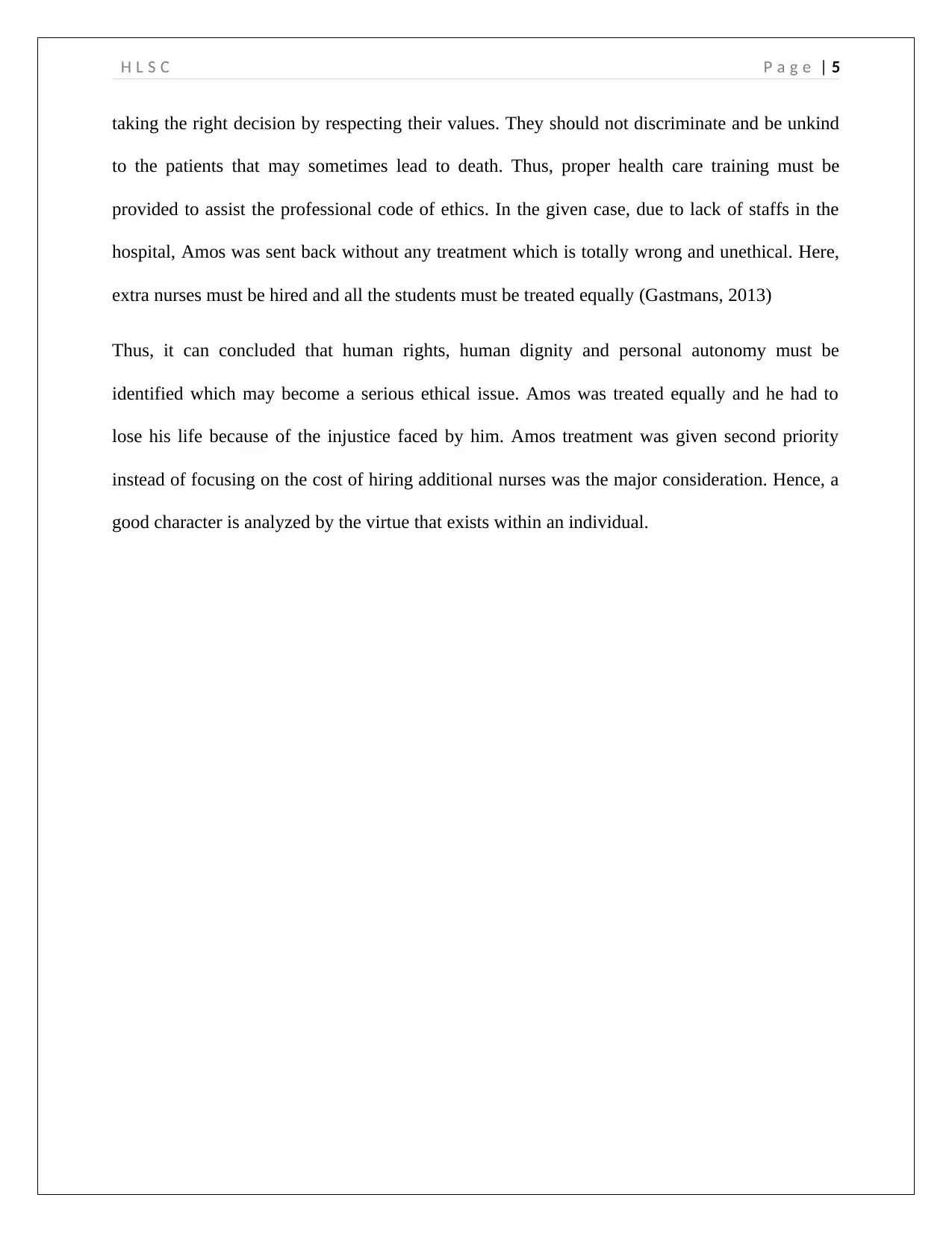
H L S C P a g e | 5
taking the right decision by respecting their values. They should not discriminate and be unkind
to the patients that may sometimes lead to death. Thus, proper health care training must be
provided to assist the professional code of ethics. In the given case, due to lack of staffs in the
hospital, Amos was sent back without any treatment which is totally wrong and unethical. Here,
extra nurses must be hired and all the students must be treated equally (Gastmans, 2013)
Thus, it can concluded that human rights, human dignity and personal autonomy must be
identified which may become a serious ethical issue. Amos was treated equally and he had to
lose his life because of the injustice faced by him. Amos treatment was given second priority
instead of focusing on the cost of hiring additional nurses was the major consideration. Hence, a
good character is analyzed by the virtue that exists within an individual.
taking the right decision by respecting their values. They should not discriminate and be unkind
to the patients that may sometimes lead to death. Thus, proper health care training must be
provided to assist the professional code of ethics. In the given case, due to lack of staffs in the
hospital, Amos was sent back without any treatment which is totally wrong and unethical. Here,
extra nurses must be hired and all the students must be treated equally (Gastmans, 2013)
Thus, it can concluded that human rights, human dignity and personal autonomy must be
identified which may become a serious ethical issue. Amos was treated equally and he had to
lose his life because of the injustice faced by him. Amos treatment was given second priority
instead of focusing on the cost of hiring additional nurses was the major consideration. Hence, a
good character is analyzed by the virtue that exists within an individual.
⊘ This is a preview!⊘
Do you want full access?
Subscribe today to unlock all pages.

Trusted by 1+ million students worldwide
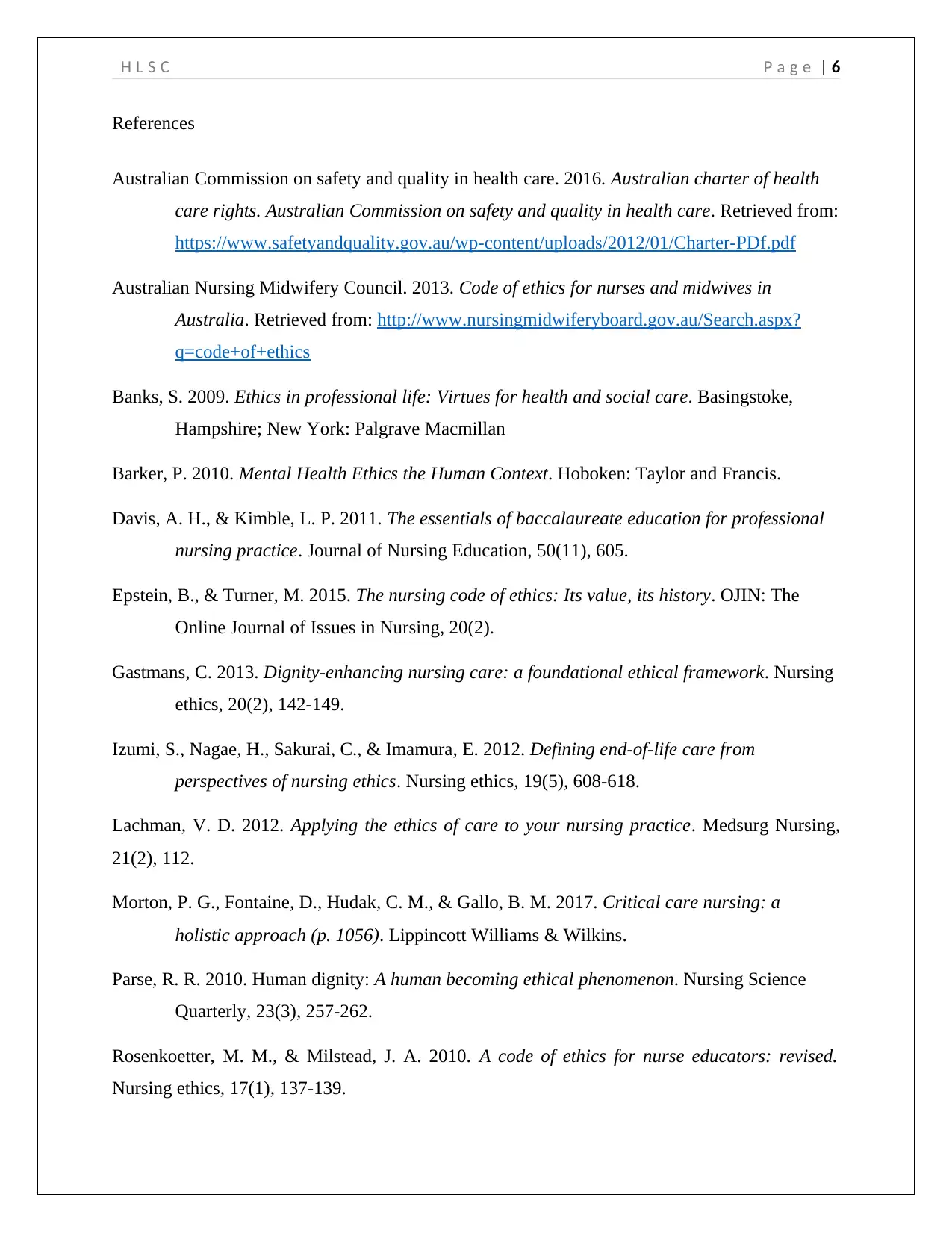
H L S C P a g e | 6
References
Australian Commission on safety and quality in health care. 2016. Australian charter of health
care rights. Australian Commission on safety and quality in health care. Retrieved from:
https://www.safetyandquality.gov.au/wp-content/uploads/2012/01/Charter-PDf.pdf
Australian Nursing Midwifery Council. 2013. Code of ethics for nurses and midwives in
Australia. Retrieved from: http://www.nursingmidwiferyboard.gov.au/Search.aspx?
q=code+of+ethics
Banks, S. 2009. Ethics in professional life: Virtues for health and social care. Basingstoke,
Hampshire; New York: Palgrave Macmillan
Barker, P. 2010. Mental Health Ethics the Human Context. Hoboken: Taylor and Francis.
Davis, A. H., & Kimble, L. P. 2011. The essentials of baccalaureate education for professional
nursing practice. Journal of Nursing Education, 50(11), 605.
Epstein, B., & Turner, M. 2015. The nursing code of ethics: Its value, its history. OJIN: The
Online Journal of Issues in Nursing, 20(2).
Gastmans, C. 2013. Dignity-enhancing nursing care: a foundational ethical framework. Nursing
ethics, 20(2), 142-149.
Izumi, S., Nagae, H., Sakurai, C., & Imamura, E. 2012. Defining end-of-life care from
perspectives of nursing ethics. Nursing ethics, 19(5), 608-618.
Lachman, V. D. 2012. Applying the ethics of care to your nursing practice. Medsurg Nursing,
21(2), 112.
Morton, P. G., Fontaine, D., Hudak, C. M., & Gallo, B. M. 2017. Critical care nursing: a
holistic approach (p. 1056). Lippincott Williams & Wilkins.
Parse, R. R. 2010. Human dignity: A human becoming ethical phenomenon. Nursing Science
Quarterly, 23(3), 257-262.
Rosenkoetter, M. M., & Milstead, J. A. 2010. A code of ethics for nurse educators: revised.
Nursing ethics, 17(1), 137-139.
References
Australian Commission on safety and quality in health care. 2016. Australian charter of health
care rights. Australian Commission on safety and quality in health care. Retrieved from:
https://www.safetyandquality.gov.au/wp-content/uploads/2012/01/Charter-PDf.pdf
Australian Nursing Midwifery Council. 2013. Code of ethics for nurses and midwives in
Australia. Retrieved from: http://www.nursingmidwiferyboard.gov.au/Search.aspx?
q=code+of+ethics
Banks, S. 2009. Ethics in professional life: Virtues for health and social care. Basingstoke,
Hampshire; New York: Palgrave Macmillan
Barker, P. 2010. Mental Health Ethics the Human Context. Hoboken: Taylor and Francis.
Davis, A. H., & Kimble, L. P. 2011. The essentials of baccalaureate education for professional
nursing practice. Journal of Nursing Education, 50(11), 605.
Epstein, B., & Turner, M. 2015. The nursing code of ethics: Its value, its history. OJIN: The
Online Journal of Issues in Nursing, 20(2).
Gastmans, C. 2013. Dignity-enhancing nursing care: a foundational ethical framework. Nursing
ethics, 20(2), 142-149.
Izumi, S., Nagae, H., Sakurai, C., & Imamura, E. 2012. Defining end-of-life care from
perspectives of nursing ethics. Nursing ethics, 19(5), 608-618.
Lachman, V. D. 2012. Applying the ethics of care to your nursing practice. Medsurg Nursing,
21(2), 112.
Morton, P. G., Fontaine, D., Hudak, C. M., & Gallo, B. M. 2017. Critical care nursing: a
holistic approach (p. 1056). Lippincott Williams & Wilkins.
Parse, R. R. 2010. Human dignity: A human becoming ethical phenomenon. Nursing Science
Quarterly, 23(3), 257-262.
Rosenkoetter, M. M., & Milstead, J. A. 2010. A code of ethics for nurse educators: revised.
Nursing ethics, 17(1), 137-139.
1 out of 7
Related Documents
Your All-in-One AI-Powered Toolkit for Academic Success.
+13062052269
info@desklib.com
Available 24*7 on WhatsApp / Email
![[object Object]](/_next/static/media/star-bottom.7253800d.svg)
Unlock your academic potential
Copyright © 2020–2025 A2Z Services. All Rights Reserved. Developed and managed by ZUCOL.



